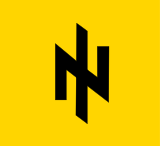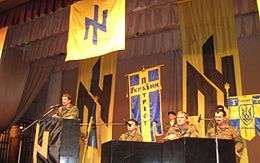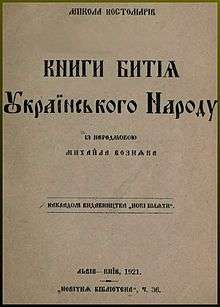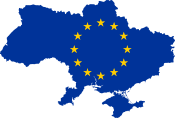Patriot of Ukraine
Patriot of Ukraine Патріо́т Украї́ни | |
|---|---|
 | |
| Leader | Andriy Biletsky |
| Founded | 2005 |
| Dissolved | 10 December 2014 |
| Headquarters | Kharkiv |
| Ideology | National Socialism |
| Political position | Far-right |
| Party flag | |
 | |
| Website | |
| http://patriotukr.org.ua/ | |
The Patriot of Ukraine (Ukrainian: Патріо́т Украї́ни) was a Ukrainian nationalist organization, defunct from December 2014. It was described as having racist and neo-Nazi political beliefs.[1][2][3][4][5] It constituted a paramilitary wing of the Social-National Assembly of Ukraine (S.N.A.), an assemblage of neo-Nazi organizations and groups[6][7][8] founded in 2008 that share the social-national ideology and agree upon building a social-national state in Ukraine.[9][10][11] Both the "Patriot of Ukraine" and the S.N.A. engaged in political violence against minorities and their political opponents.[5][12][13] The leader of the "Patriot of Ukraine" and of the Social-National Assembly is Andriy Biletsky. In interview to LB.ua (Left Bank) on 10 December 2014 Biletsky announced that the Patriot of Ukraine as political organization suspended its activities due to the war situation in the country and dissolved primarily within the Azov Battalion.[14]
History
The origin of the "Patriot of Ukraine" can be traced to Lviv where the Association of Support for the Armed Forces and Navy of Ukraine "Patriot Ukrayiny" (Ukrainian: Товариство Сприяння Збройним силам та Військово-Морському флоту України "Патріот України") was registered on 10 June 1996 as a civic association, registration number 375.[15][16][17]
The first Congress of the "Patriot of Ukraine" was held in Lviv on 12 December 1999 where it was officially adopted by the Social-National Party of Ukraine (SNPU) as its paramilitary youth wing. In the evening, around 1500 members of the SNPU and the "Patriot of Ukraine" staged a torchlight demonstration in the city. The first leader of the organization became Andriy Parubiy, who established a long-lasting tradition of torchlight parades, which became an organizational trademark. At that time Parubiy gained national notoriety in Ukraine after he was put on trial for alleged assault on communist demonstrators in Lviv on 7 November 1997. The main TV channels in Ukraine broadcast footage of Parubiy clashing with the demonstrators. The trial was dragged, moved around, and finally the case was dismissed due to the statute of limitations. A photo of Parubiy leading the "Patriot of Ukraine" march was placed on the cover of his book published in Lviv in 1999.[18]
The "Patriot of Ukraine" was dissolved by the SNPU on 14 February 2004, when the IX Congress of the SNPU adopted a new name - VO Svoboda, and elected Oleh Tyahnybok as its leader. Aiming at building a parliamentary type of political organization with an image of the "party of order", Svoboda had shaken off some old baggage, including Wolfsangel-type logo, which was replaced with the national colors and a trident (trizub) hand gesture (three raised fingers), the so-called "Trident of Liberty".[15] The original "Patriot of Ukraine" organization was also discarded since Svoboda wanted to appeal to a broader base of the Ukrainian electorate.[19] Eventually, Svoboda while still remaining a radical nationalist party was able to benefit from its new strategy: first, it scored wins at the 2010 local elections in three regions of Western Ukraine, then, it won 10.5% of the national vote during the 2012 parliamentary elections in Ukraine and created its own parliamentary faction in the Verkhovna Rada.
However, some regional branches of the Patriot of Ukraine, for example, in Zhytomyr (later renamed into Haidamaky) and also in Kharkiv, refused to disband.
Re-establishment

.jpg)
.jpg)


In 2005 the process of the re-establishment was started in Kharkiv where the Patriot of Ukraine was re-constituted as an independent political organization and subsequently registered by local authorities as a civic association on 17 January 2006, registration number 1057.[16] The Patriot of Ukraine defined itself as a "revolutionary vanguard of the Ukrainian social-nationalistic movement".[20] The organization continued to use the "Idea of the Nation" symbol (similar to Wolfsangel rune) which was initially used by the Social-National Party of Ukraine, the only difference is the color of the monogram as the SNPU used azure (blue) monogram on gold and the "Patriot of Ukraine" utilizes sable (black) on gold and gold on sable.[16] The monogram consists of a combination of the Latin letters "I" and "N". (Note that organization's propaganda materials describe the letters as Old Russian, as they were traditionally drawn before Peter the Great reformed the alphabet in 1707-1710.) The letter "N" symbolizes the central place of the national idea in organizational ideology; while the letter "I" with both ends sharpened emphasizes the unstoppable movement of ideas and triumph of the ideal over materialistic.[21]
In 2007, the organization officially ended its relationship with Svoboda, a direct descendant to the SNPU.[22] In the statement it was announced that,
Breaking all relationships with "Svoboda", the "Patriot of Ukraine" realizes that it assumes all the responsibility in the struggle for future Greater Ukraine. As an organization the "Patriot of Ukraine" is based on the "party-army" principle: it aims at creating a powerful All-Ukrainian Social-National movement, in which the new Social-National Party of Ukraine will hold a prominent place aided by storm detachments of the "Patriot of Ukraine" and the social-national trade-unions.[22]
However, despite the split some prominent Svoboda's members, such as Andriy Illienko, Chairman of the Kiev City Branch of the Svoboda ("Freedom") All-Ukrainian Union and a member of the Verhovna Rada, continued to advocate social-nationalism and idea of the two revolutions: national and social, which created a common ground with the "Patriot of Ukraine".[23][24]
Some researchers pointed to the fact that even after the declarative break-up, VO "Svoboda" continued to benefit,
From the increasing popularity of extreme-right youth movements and organizations like the Social-National Assembly (SNA), 'Patriot of Ukraine' and Autonomous Resistance, whose aim is to create 'a uniracial and uninational society.' The activities of these groups are not limited to physical or symbolic violence against ethnic and social minorities, as they also take an active part in numerous social campaigns - generally along with representatives of Svoboda - ranging from mass protests against price rises to leafleting against alcohol and drug use. Needless to say, members of these extreme-right movements are often members of Tyahnybok's party.[25][26]
Ideology and program
The Patriot of Ukraine promotes a radical nationalist, racist and neo-Nazi platform,[1][2][3][4][5] including:[27][28]
- Political violence[5][12]
- Racism[1][3][4]
- Neo-Nazism[2][4]al
- Nationocracy
- Racialism
- Aryanism
- Rejection of democracy and liberalism
- Anti-globalism
- Direct action
- National solidarity
- National hierarchy
- Fuhrerism as principle of leadership
- Obedience and personal devotion to the national leader
- Greater Ukraine - creation of the Third (after Scythia and Kievan Rus) Ukrainian Empire from Baltic to the Caucuses
Activities
In August 2011, three Patriot of Ukraine supporters were arrested and convicted in the so-called Vasylkiv terrorists case.
At the end of 2013, at the beginning of the Euromaidan protest movement, the Patriot of Ukraine created the Right Sector along with other far-right and nationalist parties and groups, including: Trident of Stepan Bandera (Dmytro Yarosh), UNA-UNSO (Oleksandr Muzychko)[29][30][31] and the White Hammer (Vladislav Goranin), although they would later be dissociated.[32]
During the Euromaidan, militants from the Patriot of Ukraine were active participants of major clashes with the riot police; according to Igor Krivoruchko, a leader of the Kiev's S.N.A. branch, on February 18, 2014, they seized and burned the headquarters of the ruling party - the Party of Regions - in Kiev.[33][34]
On April 29, 2014, the Patriot of Ukraine together with the Spilna Sprava staged a torch rally procession in Kiev to commemorate the Euromaidan fallen heroes.[35] The Self-defense of Euromaidan, attempted to disperse the rally and as a result a massive fist fight near Maidan Nezalezhnosti flared up.[36]
See also
External links
- patriotukr.org.ua (Authorization required)
- patriotukr.org.ua. Archived on Oct 17, 2014.
- rid.org.ua. Archived on Dec 18, 2014.
- МВ Рід, rid.org.ua. Archived on Oct 7, 2014.
- Студія МоNоліт The Patriot of Ukraine YouTube channel
- Patriot of Ukraine recruitment video YouTube
- S.N.A. Facebook account
- S.N.A. Twitter account
References
- 1 2 3 Shekhovstov, Anton (March 2011). "The Creeping Resurgence of the Ukrainian Radical Right? The Case of the Freedom Party.". Europe-Asia Studies. 63 (2): 203–228. doi:10.1080/09668136.2011.547696.
During the second half of the 1990s, the SNPU recruited Nazi skinheads and football hooligans. At the same time, the party decided to reorganise its ‘popular guard units’ to form the Tovarystvo spryyannya zbroinym sylam ta viiskovo-mors’komu flotu Ukrayiny ‘Patriot Ukrayiny’ (Society of Assistance to Armed Forces and Navy of Ukraine ‘Patriot of Ukraine’), headed by Andrii Parubii. However, although the ‘Patriot of Ukraine’ was formed in 1996, it was not until 1999 that it became a full-fledged organisation. Its first convention took place in Lviv in December 1999 and was celebrated by a night-time torch procession through the city streets… [In 2004, the SNPU] the convention disbanded the Patriot of Ukraine, as this paramilitary organisation as such and its overtly racist stances in particular posed a threat to the new ‘respectable’ image of the Freedom Party… The Kharkiv local organisation of the Patriot of Ukraine refused to disband and renewed its membership in 2005. The following year, it managed to register as a regional social organisation, but, from then on, it had no organisational ties with the maternal party.
- 1 2 3 Ishchenko, Volodymyr (2011). "Fighting Fences vs Fighting Monuments: Politics of Memory and Protest Mobilization in Ukraine". Debatte: Journal of Contemporary Central and Eastern Europe. 19 (1-2).
...rightist non-partisan groups including overtly racist “autonomous nationalists” (http://reactor.org.ua) and the neo-Nazi “Patriot of Ukraine” (http://www.patriotukr.org.ua/). For the far right sector politics of memory actions comprised 29.2% of all protest actions with their participation, this was larger than the shares of social-economic, political struggle, and civic rights protest issues (Table 7)… After the notorious death of Maksym Chaika in a fight with antifascists in Odessa in April 2009, Yushchenko unambiguously supported the far right interpretation of the accident claiming the victim to be “an activist of a patriotic civic association” consciously murdered by “pro-Russia militants” ignoring Chaika’s connections with rightist football hooligans and his membership in the “SICH” (“Glory and Honor”) organization, a participant in the Social-Nationalist Assembly (http://sna.in.ua/) together with the neo-Nazi group “'Patriots of Ukraine.'"
- 1 2 3 Shekhovstov, Anton (2013). "17: Para-Militarism to Radical Right-Wing Populism: The Rise of the Ukrainian Far-Right Party Svoboda.". In Wodak. Right-Wing Populism in Europe. Bloomsbury Academic.
Svoboda also seems to benefit from the increasing popularity of extreme-right youth movements and organizations like the Social-National Assembly (SNA), 'Patriot of Ukraine' and Autonomous Resistance, whose aim is to create 'a uniracial and uninational society'. The activities of these groups are not limited to physical or symbolic violence against ethnic and social minorities, as they also take an active part in numerous social campaigns - generally along with representatives of Svoboda - ranging from mass protests against price rises to leafleting against alcohol and drug use. Needless to say, members of these extreme-right movements are often members of Tyahnybok's party. Interestingly, 'street combat youth movements' like the SNA no longer focus on ethnic issues: in contrast to the older Ukrainian far right, the new groups are, first and foremost, racist movements.
- 1 2 3 4 Ghosh, Mridula (2013). Ralf Melzer, ed. The Extreme Right in Ukraine’s Political Mainstream: What Lies Ahead?. Friedrich Ebert Stiftung.
In its own internal flows of communication and control, Svoboda has always been a top-down organization that does not permit dialogue or encourage critical thinking and dissent. Yet it has made good use of “open” forms of grassroots exchanges, communicating with the public and attracting new recruits via social networks like YouTube, Facebook, Twitter and VKontakte. In this context, special mention should be made of the relations that Svoboda has maintained with what may be called the “informal” far-right, a category that includes the neo-Nazi underground, radical football fans, and hooligans. Members of these groups constitute hidden reservoirs of support for Svoboda and its ideology, Among them are those who openly propagate intolerance (e.g., by supporting total bans on immigrants, refugees, and asylum seekers), including one part of UNA-UNSO; the Ukrainian National Labor Party and Patriots of Ukraine; skinheads; followers of Hetman Pavel Skoropadskiy; Fans of the Third Hetmanate; and the Delegation of the Right from the regions. There are also those who do not champion racism, xenophobia and anti-Semitism, but nevertheless harbor other radical ideas...
- 1 2 3 4 Likhachev, Viacheslav (September–October 2013). "Right-Wing Extremism on the Rise in Ukraine". Russian Politics and Law. 51 (5). doi:10.2753/RUP1061-1940510503.
The main extrasystemic ultraright group in Ukraine in recent years has been Patriot of Ukraine (led by Andrii Bilets’kyi). The core of the organization was formed in Kharkiv in 2004, when a group of activists belonging to the SNPU’s paramilitary youth wing of the same name refused to accept the leaders’ decision to disband the militarized organization while “rebranding” their party. By 2006, Patriot of Ukraine had become a public movement with branches in many regions of the country. Activists appeared in camouflage uniform with neo-Nazi symbols. Many public actions were organized—targeting migrants, political opponents, and others. Violence (including the use of firearms) was repeatedly used against political opponents and members of ethnic and sexual minorities. In 2011, during the investigation of several criminal cases (one charge concerned the preparation of a terrorist act), almost the entire leadership of the organization in Kyiv and Kharkiv ended up behind bars; this paralyzed the movement and caused it to split… Members of almost all the organizations listed are known to have engaged in ideologically motivated violence.
- ↑ Shekhovtsov, Anton (2013). "17: From Para-Militarism to Radical Right-Wing Populism: The Rise of the Ukrainian Far-Right Party Svoboda". In Ruth Wodak. Right-Wing Populism in Europe. Blumsbury Academic. pp. 249–263. ISBN 1780932456. Retrieved 12 May 2014.
At the same time, Nova Syla's Yuriy Zbitnyev is one of the leaders of the neo-Nazi group Social-National Assembly, an organization that is also close to the younger members of Svoboda, but Nova Syla itself, while remaining on the fringes of Ukrainian politics, is not much influenced by these relations.
- ↑ Brayman, Lolita (28 February 2014). "Ukrainian nationalists strive to shake off allegations of anti-Semitism". Haaretz. Retrieved 12 May 2014.
Some Pravy Sektor protesters on the Maidan sported yellow armbands with the wolf hook symbol revealing their specific political party affiliation—that of the Social National Assembly (SNA), a largely Kiev-based neo-Nazi organization. Other more openly anti-Semitic parties are White Hammer and C14, the neo-Nazi youth wing of the Svoboda party.
- ↑ Volodymyr Batchayev; Oleg Martynenko, Association of Ukrainian monitors on observance of human rights, Ukrainian Law Enforcement, Yevhen Zakharov, Kharkiv Human Rights Protection Group. "12. Protection against discrimination, racism and xenophobia". ANNUAL HUMAN RIGHTS REPORTS / HUMAN RIGHTS IN UKRAINE, 2009-2010. Helsinki Human Rights Group. Retrieved 12 May 2014.
On the public request, the authorities stopped the musical festival «Traditions of Spirit» near Kyiv, scheduled for June 26–27, 2010, under the aegis of the radical «Social Nationalist Assembly» with the goal to promulgate among the youth the ideas of neo-Nazi and chauvinism. During the festival, the performances of ultra-right musical bands were planned («Sokyra Peruna», «Seitar», «Nachtigall», «White Lions»), who in the lyrics of their songs openly approve and show in romantic light the skinhead movement, promote Hitlerist aesthetics, and encourage to harass national minorities.
Cite uses deprecated parameter|coauthors=(help) - ↑ (Ukrainian) Андрій Білецький (Andriy Biletsky). Український расовий Соціал-Націоналізм – ідеологія організації „Патріот України” (Ukrainian racial Social-Nationalism - ideology of the Patriot of Ukraine). In: Український соціальний націоналізм (Ukrainian social nationalism). (Бібліотека організації „Патріот України”. The Patriot of Ukraine library.) Харків (Kharkiv): Патріот України (The Patriot of Ukraine), 2007, с.3-5.
- ↑ (Russian) Олег Однороженко. Социал-националистическое движение и его основные задачи (Social-nationalistic movement and its agenda). In: Український соціальний націоналізм (Ukrainian social nationalism). (Бібліотека організації „Патріот України”. The Patriot of Ukraine library.) Харків (Kharkiv): Патріот України (The Patriot of Ukraine), 2007, с.46-54.
- ↑ Shekhovtsov, Anton (2013). Right-Wing Populism in Europe: Politics and Discourse. A&C Black. p. 256.
Interestingly, 'street combat movements' like the SNA no longer focus on ethnic issues: in contrast to the older Ukrainian far right, the new groups are, first and foremost, racist movements. Their disregard for the perceived 'Ukrainian versus Russian' ethno-cultural cleavage allows them to gain support from many 'white' ultra-nationalists. Once drawn to these movements, 'white racists' also contribute to the organizational efficiency of the Svoboda party, which is, to reiterate, considered the only representative of 'white racism' in the Ukrainian electoral sphere.
- 1 2 GHOSH, MRIDULA (2011). Diversity and Tolerance in Ukraine in the Context of EURO 2012. Friedrich Ebert Stiftung.
An analysis in 2008 stated that, police investigation reports of the growing number of hate crimes after the year 2005 against foreigners and visible minorities showed that in the majority of cases the perpetrators were radical youth groups. The analysis covered such groups as Patriot of Ukraine, Ukrainian Peoples Labor Party, Ukrainian Alternative, National Action "RID", Sich, Character Kozatstvo, Svyato-Andriyivsky, Kozachiy Kurin and others… They demand total ban on migration, are against refugees and asylum seekers and the concept of tolerance. Groups such as Skinheads, followers of Hetman Pavel Skoropadskiy, Fans of the Third Hetmanate, Movement against Illegal Migration and Delegation of the Right from the Regions are those who support similar ideas.
- ↑ Volodymyr Batchayev; Oleg Martynenko, Association of Ukrainian monitors on observance of human rights, Ukrainian Law Enforcement, Yevhen Zakharov, Kharkiv Human Rights Protection Group. "12. Protection against discrimination, racism and xenophobia". ANNUAL HUMAN RIGHTS REPORTS • HUMAN RIGHTS IN UKRAINE 2009-2010. Helsinki Human Rights Group. Retrieved 12 May 2014.
As a result of the raid, several Vietnamese containers were closed, together with the goods of the aliens, and the counters of Uzbeks and Gypsies were removed. The majority of Ukrainians, who were at the open air market at that time, were approving of the actions of national-socialists. As it was already mentioned before, Ukrainians entrepreneurs who sell at the market are firmly against aliens, in particular Vietnamese, Gypsies, and Uzbeks, etc., selling their goods there. Ukrainian entrepreneurs were supported by Social National Assembly, and by the organization «Patriot Ukraiiny». With joint efforts, the patriots and the entrepreneurs forced out the majority of aliens from the open air market of Vasylkiv during the last 2 weeks.
Cite uses deprecated parameter|coauthors=(help) - ↑ Shvets, Ye. Andriy Biletsky: Half of Azov speaks in Russian language. But they die and kill for Ukraine. LB.ua. 10 December 2014
- 1 2 (Ukrainian) Андрющенко Е. С. Парамілітарні структури українського націоналістичного руху 90-х рр. ХХ ст. (Paramilitary structures of the Ukrainian nationalistic movements in the 1990s) / Е. С. Андрющенко // Наукові праці історичного факультету Запорізького національного університету : збірник / голов. ред. Ф. Г. Турченко. – Запоріжжя, 2011. – Вип. XXХ. – С. 42–51.
- 1 2 3 Olszański, Tadeusz A. (4 July 2011). "Svoboda Party – The New Phenomenon on the Ukrainian Right-Wing Scene". Centre for Eastern Studies. OSW Commentary (56): 6. Retrieved 27 September 2013.
- ↑ Ivan Katchanovski (University of Ottawa). An Interview with Reuters Concerning Svoboda, the OUN-B, and other Far Right Organizations in Ukraine, Academia.edu, 4 March 2014.
- ↑ (Ukrainian) Парубій А. Погляд справа. Статті, виступи, інтерв’ю. Львів: Орієнтири, 1999. — 44 с. Andriy Parubiy. The Right View: Publications, addresses, interviews. Lviv, 1997.
- ↑ David Stern. Svoboda: The rise of Ukraine's ultra-nationalists, BBC News, 25 December 2012.
- ↑ (Ukrainian) Official website "Patriot of Ukraine" Archived May 16, 2014, at the Wayback Machine.
- ↑ (Ukrainian) Iдея Nацiї: символiка i традицiя (Idea of the Nation: symbolism and tradition) Archived May 2, 2014, at the Wayback Machine.
- 1 2 (Ukrainian) Заява Організації „Патріот України” про розрив стосунків з ВО „Свобода” (Announcement of the Patriot of Ukraine about break-up with VO Svoboda) Archived October 6, 2014, at the Wayback Machine.
- ↑ (Ukrainian) Андрій Іллєнко (Andriy Illienko). Соціал-націоналізм і революція (Social-nationalism and revolution), Українська правда, 2 березня 2011 (March 2, 2011).
- ↑ See: Social-nationalism and VO Svoboda in: "The Return of the Ukrainian Far Right: The Case of VO Svoboda," in Ruth Wodak and John E. Richardson (eds.) Analyzing Fascist Discourse: European Fascism in Talk and Text. London and New York: Routledge, 2013, 228-255.
- ↑ Roots of Svoboda, The Jerusalem Report, December 3, 2012.
- ↑ Shekhovtsov, Anton (24 July 2012). "Security threats and the Ukrainian far right". Open Democracy. Retrieved 3 January 2014.
- ↑ (Ukrainian) Андрій Білецький (Andriy Biletsky). Український Соціал-Націоналізм (Ukrainian Social-Nationalism), Rid.org.ua. Accessed on 2 March 2014. Archived May 3, 2014, at the Wayback Machine.
- ↑ (Ukrainian) Слово Білого Вождя (White Leader Talk: Andriy Biletsky addresses, 2008-2013). Archived September 24, 2014, at the Wayback Machine.
- ↑ Groups at the sharp end of Ukraine unrest, BBC News (1 February 2014)
- ↑ "Opposition in western Ukrainian region sets up self-defence units". BBC. 10 February 2013.
- ↑ Andrew E. Kramer. Front and Center in Ukraine Race, a Leader of the Far Right, The New York Times, March 11, 2014.
- ↑ "Офiцiйна заява "Правого Сектору" (Official announcement of the "Right Sector")". Політрада «Правого сектору» (in Ukrainian). Right Sector. Retrieved 6 March 2014.
- ↑ (Russian) Маргарита Чимирис, Анастасия Браткова (Margarita Chemeris, Anastasia Bratkova). Кто шагает с правой: Радикалы Майдана хотят продолжения революции. Власть называет их провокаторами (Who walks right: Maidan radicals want to continue revolution. Authorities call them provocateurs), Internet-newspaper Vesti.ua, № 12(30), 4–10 April 2014.
- ↑ Radical protesters burst into Party of Regions' Kyiv office, Kyiv Post, February 18, 2014.
- ↑ (Ukrainian) Смолоскипний марш на честь полеглих Героїв Небесної сотні (Torch rally procession in commemoration of fallen Heroes of the Heaven's Hundred) Photos. Archived 2014-05-02 at WebCite
- ↑ (Ukrainian) На київському Майдані сталася бійка (A fist fight at the Kiev's Maidan), Дзеркало тижня, 29 April 2014.
| Wikimedia Commons has media related to Patriots of Ukraine. |
